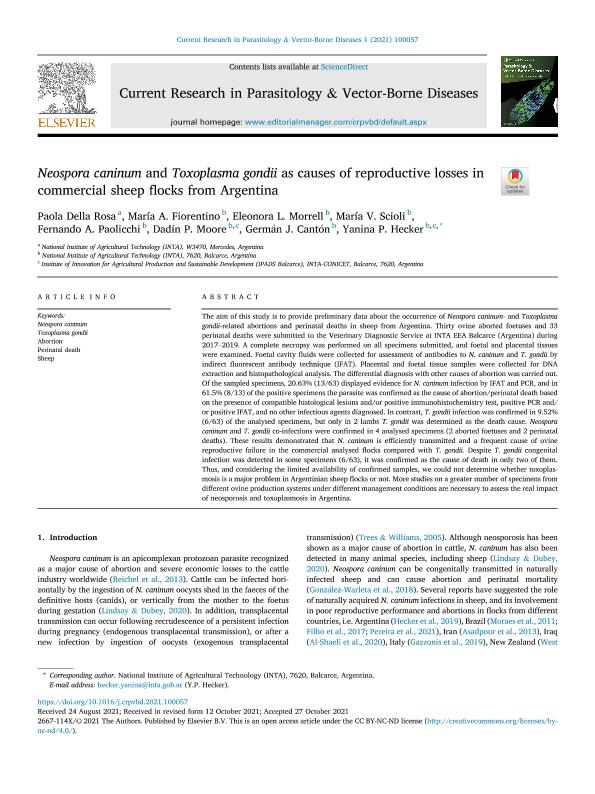Artículo
Neospora caninum and Toxoplasma gondii as causes of reproductive losses in commercial sheep flocks from Argentina
Della Rosa, Paola ; Fiorentino, Maria Andrea
; Fiorentino, Maria Andrea ; Morrell, Eleonora Lidia
; Morrell, Eleonora Lidia ; Scioli, María V.; Paolicchi, Fernando Alberto; Moore, Dadin Prando
; Scioli, María V.; Paolicchi, Fernando Alberto; Moore, Dadin Prando ; Canton, German; Hecker, Yanina Paola
; Canton, German; Hecker, Yanina Paola
 ; Fiorentino, Maria Andrea
; Fiorentino, Maria Andrea ; Morrell, Eleonora Lidia
; Morrell, Eleonora Lidia ; Scioli, María V.; Paolicchi, Fernando Alberto; Moore, Dadin Prando
; Scioli, María V.; Paolicchi, Fernando Alberto; Moore, Dadin Prando ; Canton, German; Hecker, Yanina Paola
; Canton, German; Hecker, Yanina Paola
Fecha de publicación:
11/2021
Editorial:
Elsevier
Revista:
Current Research in Parasitology and Vector-Borne Diseases
ISSN:
2667-114X
Idioma:
Inglés
Tipo de recurso:
Artículo publicado
Clasificación temática:
Resumen
The aim of this study is to provide preliminary data about the occurrence of Neospora caninum- and Toxoplasma gondii-related abortions and perinatal deaths in sheep from Argentina. Thirty ovine aborted foetuses and 33 perinatal deaths were submitted to the Veterinary Diagnostic Service at INTA EEA Balcarce (Argentina) during 2017–2019. A complete necropsy was performed on all specimens submitted, and foetal and placental tissues were examined. Foetal cavity fluids were collected for assessment of antibodies to N. caninum and T. gondii by indirect fluorescent antibody technique (IFAT). Placental and foetal tissue samples were collected for DNA extraction and histopathological analysis. The differential diagnosis with other causes of abortion was carried out. Of the sampled specimens, 20.63% (13/63) displayed evidence for N. caninum infection by IFAT and PCR, and in 61.5% (8/13) of the positive specimens the parasite was confirmed as the cause of abortion/perinatal death based on the presence of compatible histological lesions and/or positive immunohistochemistry test, positive PCR and/or positive IFAT, and no other infectious agents diagnosed. In contrast, T. gondii infection was confirmed in 9.52% (6/63) of the analysed specimens, but only in 2 lambs T. gondii was determined as the death cause. Neospora caninum and T. gondii co-infections were confirmed in 4 analysed specimens (2 aborted foetuses and 2 perinatal deaths). These results demonstrated that N. caninum is efficiently transmitted and a frequent cause of ovine reproductive failure in the commercial analysed flocks compared with T. gondii. Despite T. gondii congenital infection was detected in some specimens (6/63), it was confirmed as the cause of death in only two of them. Thus, and considering the limited availability of confirmed samples, we could not determine whether toxoplasmosis is a major problem in Argentinian sheep flocks or not. More studies on a greater number of specimens from different ovine production systems under different management conditions are necessary to assess the real impact of neosporosis and toxoplasmosis in Argentina.
Palabras clave:
ABORTION
,
NEOSPORA CANINUM
,
PERINATAL DEATH
,
SHEEP
,
TOXOPLASMA GONDII
Archivos asociados
Licencia
Identificadores
Colecciones
Articulos (IPADS BALCARCE)
Articulos de INSTITUTO DE INNOVACIÓN PARA LA PRODUCCIÓN AGROPECUARIA Y EL DESARROLLO SOSTENIBLE
Articulos de INSTITUTO DE INNOVACIÓN PARA LA PRODUCCIÓN AGROPECUARIA Y EL DESARROLLO SOSTENIBLE
Citación
Della Rosa, Paola; Fiorentino, Maria Andrea; Morrell, Eleonora Lidia; Scioli, María V.; Paolicchi, Fernando Alberto; et al.; Neospora caninum and Toxoplasma gondii as causes of reproductive losses in commercial sheep flocks from Argentina; Elsevier; Current Research in Parasitology and Vector-Borne Diseases; 1; 11-2021; 1-7
Compartir
Altmétricas



